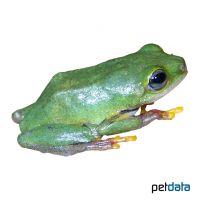Lime Reed Frog (Hyperolius fusciventris)
| Lime Reed Frog Hyperolius fusciventris | |
|---|---|
| Name | Lime Reed Frog |
| Name Lat. | Hyperolius fusciventris |
| Family | African Reed Frogs |
| Family lat. | Hyperoliidae |
| Order | Frogs & Toads |
| Order lat. | Anura |
| Origin | Africa |
| Habitat | Forest |
| Diet | Small live insects |
| Humidity | 70-90 % |
| Behavior | Peaceful, nocturnal |
| Keeping | Pair, group |
| Care Level | Easy |
| Breeding | Moderately difficult |
| Housing | Semi-humid terrarium |
| Life Span | 5 years |
| Protection | No |
| Metric Units | |
| Size | 2.5-3.5 cm |
| Temperature | 22-28 °C |
| Housing Size | 30 x 25 x 50 cm |
| US Units | |
| Size | 1"-1.4" |
| Temperature | 72-82 °F |
| Housing Size | 10" x 10" x 20" |
Distribution and habitat
The range of the nocturnal green reed frogs is along the West African coast from Guinea through Liberia and Nigeria to Cameroon, where they live at the edge of tropical forests, in moist savannas and in cultivated land near perennial and temporary water bodies. They are highly variable in coloration and markings. Several subspecies are known in their range.
Maintenance
For 1-3 animals the terrarium size should be at least L 30 x W 25 x H 50 cm. The terrarium should be placed in a quiet, vibration-free place without sunlight.
You need a terrarium with a substrate of loose, absorbent, non-rotting substrate such as. Sand-peat mixture, coconut fibers or Sphagnum moss with a drainage, in addition pieces of bark, flat stones, structured back and side walls, strongly branched climbing branches, preferably entwined by climbing plants, a dense planting (e.g. Tradescantia, Ficus, Hoya, Bromeliads) and a large, shallow water basin with plants towering above. Potted plants that can be easily removed for cleaning are advantageous. Daily, the inside of the terrarium should be finely sprayed with water (humidity), but a rain or mist system is better.
| Temp. day: 22-28 °C | Temp. night: 18-22 °C | Humidity: 70-90 % |
Thermostatically controlled floor heating (heating mats) is recommended. The lighting duration must be 10-14 hours depending on the season. Daylight fluorescent tubes with low UV content are very suitable.
Diet
The food supply consists of live insects such as Drosophila, flies, ants, spiders, micro crickets, cockroaches, tiny grasshoppers and crickets as well as meadow insects (meadow plankton). After a period of habituation (feeding with tweezers), special ready-made food for insectivores is often accepted. Food should be offered to adult animals 2-3 times a week, young animals must be fed daily. Feeding should be done in the evening hours. It is important to add minerals and vitamins regularly (e.g. by dusting the feeders). The quality of the feed animals can be enhanced by feeding overripe fruit and honey water
A varied diet promotes health and prevents deficiency symptoms.
Reproduction and breeding
Males and females are difficult to distinguish externally. Females grow slightly larger, males can be recognized by their sound bladder and loud call.
Usually after rainfall, the female ready to spawn is taken in the mating grip (amplexus) by the male and it lays about 10-100 eggs in a gelatinous clutch on plants (adhesive spawners) above a water surface. Depending on the temperature, the larvae (tadpoles) hatch after a few days and drop into the water below with the liquefying clutch. They initially filter microorganisms from the water and later eat plant food. After about 2.5 months, the transformation (metamorphosis) is complete and the young frogs leave the water. Life expectancy can be over 5 years.
Important
In nature they often sit on grasses in the sun, so a sunny spot should be set up with a spotlight (30-35 °C). The fingers and toes of these tree dwellers have adhesive discs. Juveniles change color as they mature. To observe the nocturnal animals, it is recommended to install a special night or moonlight.
Prior to purchase, a terrarium should be prepared that meets the species specific needs. Good ventilation without drafts is necessary, as well as equipment for measuring temperature and humidity. The lighting has to correspond to the species-specific day-night rhythm and should be placed in such a way that the animals cannot injure themselves. The terrarium should be locked in such a way that neither unauthorized persons can open it nor the animals can escape. Special attention must be paid to thorough hygiene and impurities must be removed regularly
Further literature can be found in your pet store.
References
Text: petdata; Image: petdata
Source: VDA & DGHT (2006): Haltungsrichtlinien für die Haltung von Anuren; ENGELMANN (2006): Zootierhaltung - Tiere in menschlicher Obhut: Reptilien und Amphibien, Harri Deutsch Verlag
- Gemäß § 21 Abs. 5 Tierschutzgesetz idgF
